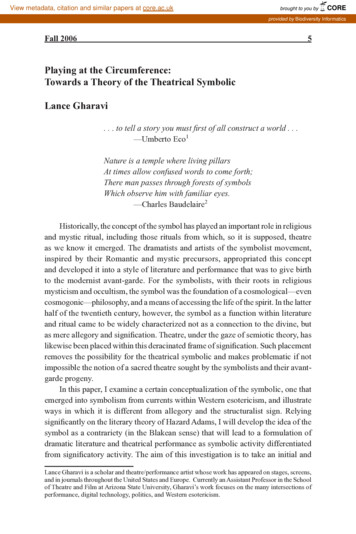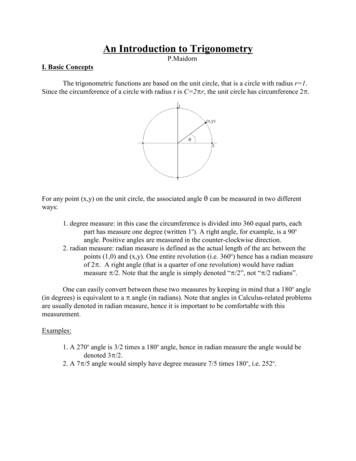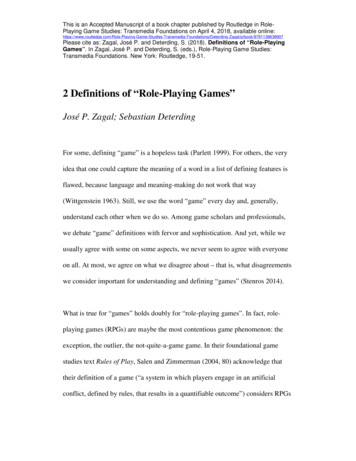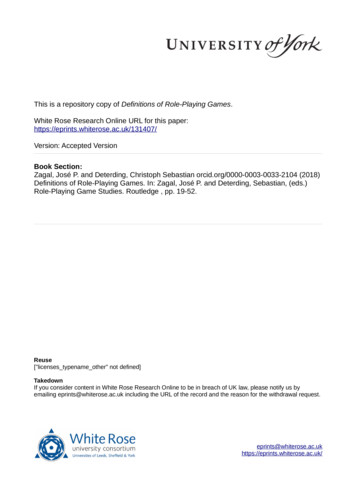
Transcription
View metadata, citation and similar papers at core.ac.ukbrought to you byCOREprovided by Biodiversity InformaticsFall 20065Playing at the Circumference:Towards a Theory of the Theatrical SymbolicLance Gharavi. . . to tell a story you must first of all construct a world . . .—Umberto Eco1Nature is a temple where living pillarsAt times allow confused words to come forth;There man passes through forests of symbolsWhich observe him with familiar eyes.—Charles Baudelaire2Historically, the concept of the symbol has played an important role in religiousand mystic ritual, including those rituals from which, so it is supposed, theatreas we know it emerged. The dramatists and artists of the symbolist movement,inspired by their Romantic and mystic precursors, appropriated this conceptand developed it into a style of literature and performance that was to give birthto the modernist avant-garde. For the symbolists, with their roots in religiousmysticism and occultism, the symbol was the foundation of a cosmological—evencosmogonic—philosophy, and a means of accessing the life of the spirit. In the latterhalf of the twentieth century, however, the symbol as a function within literatureand ritual came to be widely characterized not as a connection to the divine, butas mere allegory and signification. Theatre, under the gaze of semiotic theory, haslikewise been placed within this deracinated frame of signification. Such placementremoves the possibility for the theatrical symbolic and makes problematic if notimpossible the notion of a sacred theatre sought by the symbolists and their avantgarde progeny.In this paper, I examine a certain conceptualization of the symbolic, one thatemerged into symbolism from currents within Western esotericism, and illustrateways in which it is different from allegory and the structuralist sign. Relyingsignificantly on the literary theory of Hazard Adams, I will develop the idea of thesymbol as a contrariety (in the Blakean sense) that will lead to a formulation ofdramatic literature and theatrical performance as symbolic activity differentiatedfrom significatory activity. The aim of this investigation is to take an initial andLance Gharavi is a scholar and theatre/performance artist whose work has appeared on stages, screens,and in journals throughout the United States and Europe. Currently an Assistant Professor in the Schoolof Theatre and Film at Arizona State University, Gharavi’s work focuses on the many intersections ofperformance, digital technology, politics, and Western esotericism.
6Journal of Dramatic Theory and Criticism3humble step towards a theory of theatre as symbolic activity that will suggestmeaningful and non-alienating connections to the mystic aspects of ritual.Most contemporary theory posits drama and theatre as signification. Thedifficulty with this model, as useful as it is, is that it situates theatre, drama, andother forms of communication as radically cut off from meaning and the world bythe unbridgeable gulf that divides reference from referent. The dilemma constructsa seemingly unassailable obstacle for the various forms of holy or sacred theatreattempted by numerous figures of the twentieth-century avant-garde. In theseperformances, under the model of signification, every utterance, every gesture,even the performed actions themselves, serves only as indeterminate pointers tothe spiritually transcendent. The Divine is banished from the stage, flung downthe infinite staircase of the Saussurean signifying “chain.” Such pointing, suchsignification, far from bringing the activity closer to the holiness it seeks, servesonly to reify, indeed, to construct, the unbridgeable distance between humankindand the Divine.If, as I suggest below, the symbol is a function that operates quite differentlyfrom signification or representation, then, for the symbol to exist as a function withintheatre or drama at all, both must be conceived of as activities that are somethingother than “mere” signification. I do not offer an argument against the model ofsignification, much less a refutation. My goal here is to sketch the outlines of adifferent model, to make room for the possibility of the dramatic and theatricalsymbolic. In doing so, I will transpose, into a theatrical context, Hazard Adams’sapproach to the literary symbolic while incorporating certain concepts from thetraditions of Western esotericism. The model of theatre and drama formulated inthis examination will apply beyond the narrow and circumscribed boundaries ofthe historic symbolist movement to encompass a view of theatrical activity in amore general sense. Articulating this model will involve, in part, an initiation orrenewal of a formulation of theatre that has become buried within the sepulcher ofreprobate theory. Further, though I draw upon the concept of holy theatre as I tracethe contours of this model, I consider the question of a holy theatre as separate fromthe concept of theatre as symbolic activity. My concern here is with the latter. Theestablishment of the latter will make possible the former.Among the foundational ideas of the mystic metaphysics that informedsymbolist philosophy and practice, the concept of correspondence is perhaps themost vital. The symbolists drew this concept from a set of esoteric traditions thatincludes Kabbalah, Gnosticism, magic, alchemy, and Hermeticism. These traditionsare not monolithic. They each constitute a diverse array of beliefs, practices, andphilosophies. Further, though they are distinct from one another, each of thesetraditions is highly syncretic; the branches of their thought intertwine and connectlike vines in an overgrown garden. While noting the differences within and amongthese traditions, Antoine Faivre, one of the founders of the modern study of Western
Fall 20067esotericism, cites several defining characteristics shared by all; the first of these iscorrespondence.4 The ancient notion of correspondence is based on the conceptsof the macrocosm and microcosm that seem at once to reinforce and to deny adualistic understanding of cosmology. According to this idea, human life andaction (microcosm) are sensible manifestations of greater cosmic figures, forces,and movements (macrocosm). This concept is most succinctly summarized inthe opening lines of The Emerald Tablet of Hermes Trismegistus, lines that arecommonly further reduced to the familiar mystic saying, “As above, so below.”Hermes Trismegistus, or “Thrice-Greatest Hermes,” was the Greek incarnation ofthe Egyptian deity, Thoth, and the supposed author of those documents that formthe foundation of the Hermetic tradition. In the Introduction to the anthology TheOccult in Russian and Soviet Culture, Bernice Glatzer Rosenthal states that:Symbolic and real correspondences are said to connect all partsof the visible and invisible world: “That which is above is likethat which is below, to perpetuate the mystery of the one thing”. . . according to the Emerald Tablet of Hermes Trismegistus.These correspondences are more or less veiled at first glance;they have to be decoded. Everything in the universe is a symbolor sign. Everything harbors and manifests mystery.5The panoply of Western religions, esoteric philosophies, and mystic and occulttraditions, from Hermetism and the magic of the ancient Egyptians to the Kabbalahand contemporary Christianity, exhibits a broad and multi-colored diorama ofmetaphysical thought. All of these, however, are based upon a dualistic metaphysicsthat assumes a primordial Fall or at least a cosmogenetic bifurcation of realityinto two constituent realms. The first of these two realms is variously referredto as nature, matter, the temporal, the particular, or the phenomenal realm. Thesecond realm is referred to alternatively as the Spirit, the immaterial, the eternal,the ideal, nothingness, silence, the universal, or the noumenal realm. The formerrealm, characterized by plurality, includes humankind and all that is perceivableto it. The latter is usually described as ineffable and unknowable; it is the realmof—variously, and among others—God, the Platonic forms, nous, or the collectiveunconscious and is characterized by unity. The relationship of these two realms istraditionally described, through spatial metaphor, as vertical. The realm of matteris “below” and the realm of Spirit is “above.”The term “correspondence” further describes this relationship in a mannerthat is apparently contradictory. According to the Emerald Tablet, the world ofmatter can be said to correspond to the world of Spirit because the two realmsare not merely similar, that is, the world of matter and multiplicity is not merely areflection of the Spirit, but rather, they are united in “the mystery of the one thing.”
8Journal of Dramatic Theory and CriticismThis “one thing” contains and is contained by the multiplicity and particularity ofthe material realm. “In a word,” as Emanuel Swedenborg notes, “all things whichexist in nature from the least to the greatest thereof, are correspondences.”6 Sosomething strange happens when the theory of correspondence is applied to theFall. Correspondence reveals the essential “one-ness” of the two worlds. The Fallis reversed, and duality is encompassed by unity. There is no bifurcation, for alloppositions are united in the “one thing.” The Kabbalists, for whom correspondenceis a foundational concept, call this unity “God.” In Shi’ur Qomah, the sixteenthcentury Kabbalist Moses Cordovero states:The Essence of divinity is found in every single thing—nothing but it exists. Since it causes every thing to be, no thingcan live by anything else. It enlivens them; its existence existsin each existent.Do not attribute duality to God. . . . If you suppose that EinSof emanates until a certain point, and that from that point onis outside of it, you have dualized. God forbid! Realize, rather,that Ein Sof exists in each existent.7The Kabbalists resolve the duality of the Fall and the ancient problem of “the oneand the many” by claiming that the opposition of spirit and matter are unified in,and inseparable from, God. This action of unification is the basis for correspondencetheory.The idea of God as a unification of opposites, as a wholeness that encloses acoincidentia oppositorum, as an encompassing Spirit that unifies, contains, and isAll, is not limited to spiritually esoteric traditions. It is, for example, a foundationalidea in Hegelian metaphysics. Hegel, even in his early writings, speaks out againstthe idea of the Divine as alien, remote, and purely transcendent. For Hegel, as hewrites in his “Fragment of a System,” God is the unification of the opposition of theone and the many—or, as he puts it, the infinite and the finite. But not, he claims,simply as a dead relation among a universe of multiplicity, a unity as conceptualabstraction. Rather, God is a “living unity of the manifold.”8For the symbolists, who attempted to communicate a spiritual or universalexperience in the language of the sensible and particular, symbols—those objects,images, words, or actions that correspond—are an ideal tool. For if the symbol isthat which corresponds, then every word, every object in nature, every action, isa symbol that manifests the mystery of the Divine. Thus did Baudelaire pen thehypnotic suggestion that “man passes through a forest of symbols.”9The mystery of the symbol lies in the inner contradiction implied by thistheory, a contradiction between the necessary duality of two realms and a monistic“one thing.” Carlo Sini has suggested that the origins of the word “symbol” bothimply and resolve such a contradiction. According to Sini, the term derives from
Fall 20069the original Greek verb sym-ballein, meaning “putting together.” The symbolonwas the broken half of an object that could be united with its other half to serve asa means of recognition. Thus the symbol is a fragment of an original whole. Sinidescribes the symbol as a very special kind of sign. The symbol, like any sign, stillrefers or signifies, yet the signifier and signified are not “other.” “The symbol,”claims Sini, “does not refer to an ‘other,’ to a ‘different from itself’ but still to itself,to the ‘same’—the other to which the symbol refers is still to itself. . . . Each [part]is there to say that it is what it is because it derives its being from the unity thatcontained it, that kept it together.”10Sini’s description of the self-identification of the symbol, its “non-othered”relation to that to which it refers, is something very close to what we need for ourtheory. The difficulty with Sini’s claim is that he conceives of the relationshipbetween the symbol and its “not-other” as one of signification, as reference andreferent, signifier and signified. But this flies in the face of Saussure and subsequenttheorists who have shown that the signifier and signified can never coincide. Inorder to resolve this difficulty, we need to conceive of the relationship between thesymbol and its “not-other,” its “partner,” its “double,” if you will, as somethingother than signification. We need to identify the nature of this relationship.Sini’s identification of the symbol as the coincidence of opposed or “othered”elements echoes the thinking of the symbolists and their antecedents, the Romantics,in both Europe and Russia. It is this characterization that differentiates symbol fromallegory. In The Philosophy of Art, Friedrich Schelling draws the distinction:That representation, however, in which the particular means the universal,or in which the universal is intuited through the particular is allegory.The synthesis of these two, where neither the universal means theparticular, nor the particular the universal, but rather where both areabsolutely one, is the symbolic.11It is important to note that Schelling describes the allegoric relationship in terms ofsignification. The allegory signifies or represents, by means of figurality, that whichit is not. Thus the lion is an allegory for courage in that, while the lion is entirelyseparate from courage, the former refers to or signifies the latter. By contrast, thesymbolic relationship is one of coincidence and tautology; both are “absolutely one.”Schelling’s “universal” and “particular” are part of a set of associated oppositionslike “one and many,” and “above and below” that are unified in the correspondencetheory of the symbolic.Mircea Eliade describes the relationship between the symbolic “partners” byinvoking the concepts of immanence and archetype. He conceives of the worldas a non-linguistic language composed of objects that enclose archetypes that areimmanent within them.12 Here, the “above” is identified with archetypes that arein a relationship of immanence with the “below.” Symbols, for Eliade, are these
10Journal of Dramatic Theory and Criticismnon-linguistic objects—part of the world—that are signified by words. In this case,the world is a non-linguistic language of correspondences and our own linguisticlanguage is “signification and an imitation of the true language which is theworld itself.”13 This conception leaves room for a theatrical symbolic if theatre isconceived of as in and of the world, as opposed to something that is somehow setapart from the world and merely signifies objects and events therein. Theatre, in theformer case, would be part of the non-linguistic world of symbols that correspond tothe archetypes that are immanent within it. Yet for Eliade, there can be no literary orverbal symbolic based on correspondence. In his conception, our language merelyrefers to the world of symbols through signification. Language and the world arethus, in Eliade, irredeemably separated. We must turn to Hazard Adams and histheory of the literary symbolic if our theatrical symbolic is to include language.To describe the correspondence conception of the symbol, Hazard Adams usesthe example of the Eucharist in which the bread and wine do not merely representthe body and blood of Christ, but rather that the bread and wine are coincidentwith and contain the body and blood of Christ.14 Adams refers to this relationshipof correspondence between two separate realities—one of which is “fallen”—asthe “miraculous symbolic,” and contrasts it to his own conception of the “secularsymbolic.” This “secular” concept of the symbol is similar to the “miraculous”type in that both involve the coincidence of signifier and referent, yet the formeroperates without the mystical baggage or the Fall implied by the latter. Adams’sconception of the secular symbolic is based on a theory of language as “prolific”or creative rather than as significatory. I shall return to this notion, a crucial onefor Adams, later in this essay.There are three sets of terms that Adams, borrowing from William Blake,introduces to construct his notion of the secular symbolic: circumference andcenter; myth and antimyth; and contraries and negations. Center and circumferencedescribe different and opposing metaphysical perspectives. When standing at thecenter, all that is—experience, nature, or any referent—is without or outside ofthe self. Even in a mode of reflexive self-analysis, the self is projected outside ofthe self as other. The entire world is alien and the self is a member of what Blakecalls the “priesthood” that interprets this other. At the circumference, all that is isinside and part of the self. “You contain the world in the form your imagination,including your power of language, gives it.”15 The circumference contains and isall, while the center excludes all as other.Blake’s concepts of myth and antimyth are closely related to circumferenceand center. The condition of myth, according to Adams, involves the placementof all that is, again, including the power of language, inside the imagination andthe identification of each individual element with the whole while maintainingthe individuality of each element. Thus in myth, there is a paradox: the particularencompasses the whole and the whole, every particular. Antimyth is the reverse of
Fall 200611this state. It is the externalization and objectification of all that is. It involves, “anisolated, purely subjective and totally passive consciousness, alien to everythingelse.”16 At the antimythic pole, one points outward to everything as other, as allegorysignifies or points towards that which is not itself. Myth is thus circumferentialwhile antimyth is a center. Adams constructs a continuum, or rather, a cycle, onwhich he places various humanistic activities including language and myth, art,criticism, history, religion, and mathematics (in that order) in a range betweenmyth and antimyth.17The Blakean concept of negation involves a binary opposition—like subject/object—wherein one side is central and privileged and the other side is repressedand marginalized. Furthermore, each constituent in the opposition is identified aswhat it is by virtue of the fact that it is not the opposing constituent. Contrariety isa circumferential form that encloses a duality wherein one side is the distinctionbetween the two elements while the other side is the denial of such a distinctionin favor of the identity of the two. “Identity,” for Adams, is precisely the contraryto the distinction difference/non-difference. Thus, rather than deconstructinghierarchical dualities as Jacques Derrida deconstructed speech/writing, the contraryencloses duality in a unity. The terms of the opposition are both different and thesame and neither merely the same nor merely different. Contrariety operates as asyzygy in the Jungian sense, the conjunction of a pair of opposites results in thetwo becoming one.It is important to point out that the contrariety, as an enclosing union ofoppositions, does not affect the complete erasure of all distinction between theconstituents. As in Hegel’s “Fragment of a System,” opposites are both posited andunited; that is, neither term is dissolved while both are one. This idea is succinctlymanifest in the Chinese symbol of the yin-yang. The yin-yang is composed of acircle divided in half by a backwards S-curve. The black half (yin) and the whitehalf (yang) each contain a small circle of their opposite color. That the two apparentopposites are enclosed within the circumference of a circle, the symbol of cosmicunity, reveals that the polar duality of the yin and yang are one. The presence ofthe small circle of black in yang and the small circle of white in yin reveals thateach half contains the seed of the other. As the seed grows, the yin becomes yangand the yang, yin. The two forces are not in conflict, the one negating the other.They are dynamically interdependent, constantly striving to complete one another.They are a duality in unity and a unity in duality.We see another example of this in Viachelav Ivanov’s essay, “The Essence ofTragedy.” For Ivanov, Apollo signifies the principle of unity, or the monad, whileDionysus signifies the principle of duality, or the dyad. This monad/dyad is anopposition. Unlike Nietzsche, Ivanov sees tragedy as essentially Dionysian. Yet heswerves back somewhat towards a Nietzschean position with regard to tragedy whenhe briefly uses the term dyad in a different sense. The dyad, in Ivanov’s thought, is
12Journal of Dramatic Theory and Criticismthe contrary to the monad/dyad opposition. “The concept of the dyad presupposesan initial, intrinsic unity, in which internal opposition is revealed. From the verystart, this existence must harbor a certain duplicity within itself—not as an innercontradiction, but as an inner wholeness.”18 Yet this concept of the dyad harborsthe necessity of the temporal. For Ivanov, this contrariety is a unified primordialstate that does not endure, for “as the energy concealed in it grows,” the unity istorn apart into opposition, into “masks of division and discord.”19 This action isdepicted in the Dionysian myth through the suffering of the dismembered god.The concept of contrariety is a paradox involving a coincidentia oppositorum—a union of opposites or otherwise “othered” elements. This is a paradox thatreoccurs throughout the history of mystic and esoteric thought. It may be seen inthe writings of Vladimir Solov’ev in the form of the chemical marriage and theconcept of sobornost (a social and religious term that encompasses the concept ofunity in multiplicity and multiplicity in unity). It appears throughout alchemy inthe form of iconography and concepts like the androgyne and the wedding of theKing and Queen. In Christianity, it is present in what Kierkegaard referred to as theAbsolute Paradox—the simultaneous divinity and humanity of Christ. This paradox,according to Søren Kierkegaard, is that beyond which thought cannot go. It is the“undoing” of thought, the collision of thought with that “which thought cannotthink.”20 Hegel comes to much the same conclusion when he states that the unionof oppositions “is not something propounded by the understanding or by reflectionbut has a character of its own, namely, that of being a reality beyond all reflection.”He thus reaches the conclusion that philosophy “has to stop short of religion. . . .”21In this paradox of contrariety, a in a/b is both b and not b. It is a circumferentialform. It must therefore be placed at the mythical pole. Antimyth cannot accept suchparadox—or any paradox, for that matter—for logic stands at the antimythical poleand the paradox of identity violates both the law of non-contradiction and the lawof the excluded middle. Since it transgresses the fundamental laws of thought, sucha paradox, as both Kierkegaard and Hegel suggest, is not accessible by means ofrational thought, much less any discursive explanation. In his Tractatus LogicoPhilosophicus, Wittgenstein states, “We cannot think what we cannot think; so whatwe cannot think we cannot say either.”22 Later in this same work, he continues thisthought: “There are, indeed, things which cannot be put into words. They makethemselves manifest. They are what is mystical.”23 Wittgenstein is articulatinghere that there are some things that cannot be said. They must be shown. Hencethe iconography of the symbol in mystic traditions. Hence the non-discursivity ofpoetry. Hence the theatre.Adams identifies the symbolic with the terms myth, circumference, andcontrariety. As it involves the paradox of the union of oppositions, the symbolicis a contrariety. Since myth is the condition in which the particular encompassesthe whole and the whole every particular, the symbol as correspondence—the
Fall 200613miraculous symbol—is within the circumferential form of myth. It harbors withinits circumference both the “above” and “below,” placing these in a condition ofidentity without effecting the erasure of either. Adams’s secular symbolic is likewisemythic and likewise a contrariety. Both of these conceptions of the symbolicinvolve the coincidence of “partners,” the symbol and its “double” described bySini. The symbol is the contrary to the negation subject/object or signifier/signified.It is, as Kierkegaard describes the Absolute Paradox, the condition of “absoluteunlikeness in absolute likeness.”24 Allegory and signification, on the other hand,are antimythic, upholding the logical oppositions and negations of sign/referentand subject/object.At this point, I think it worthwhile to state, parenthetically, two things. First,though the concept of the symbol as contrariety, as a paradox, and therefore as “thatwhich we cannot think,” may seem to be a philosophical giving up, a “game calledon account of mystery,” it is no more so than the retreat into mystery that constitutesthe arrival at the “play of differences”—a concept initiated by Saussure and onethat Derrida, as he takes pains to point out, wrestled away from intelligibility intoa realm of utter darkness.Secondly, this conceptualization of the symbol—the mythic, circumferentialcontrariety of Adams, the joining of the broken halves described by Sini—suggestsa kind of wholeness that stands in marked contrast to the “fissure” or the “gap”that fractures the Saussurean sign, that makes its meaning unknowable andinfinitely deferred, that banishes presence. But the “wholeness” of the symbolicas correspondence—insofar as the correspondence symbolic participates in, or isin fact, wholly Divine—is also a kind of “holeness,” a “nothingness.” By this, Imean something more than that the symbol, in this conception, acquires somethingof the idiot stare of paradox. In the correspondence model, the “above” realm is,as I have noted, often described as Nothing, Silence, ineffable and unknowable.The Kabbalists specifically refer to the Divine, Ein-Sof, as Ayin, or “Nothing.”The contrariety of the correspondence symbol, the joining of the halves broken bythe Fall, may thus be understood as completing not a whole, but a hole; oppositescome together to form a nothing, or, rather, Nothing. In this sense, the symbolis a circumference that encloses an “all” and excludes or externalizes nothingwhile simultaneously enclosing only “nothing.” The circumference is both awhole and a hole, a fullness and an absence. All symbols, in the sense that theyare correspondences, participate simultaneously in All and in Nothing which, inthe circumference that is the mystic’s Divine, are one. Insofar as it participates inAyin, the fertility of the symbol as the object of a robust hermeneutic activity isunderstandable. Nature, and our nature, abhors a vacuum; hence the fecundity ofthe symbol, its indeterminacy, dynamism, and generative capacity.The structuralist’s “play of differences” offers a similar mystery. Difference—the system that structures, among other things, language—in the hands of Derrida
14Journal of Dramatic Theory and Criticismbecomes “différance,” a term he struggles to identify (or not identify) by resortingto a kind of negative theology. He describes what différance is not. The difference,he points out, that lets phonemes be heard, that allows words to be understood, isitself inaudible. This difference, even in graphic rather than aural contexts, escapesinto darkness and away from intelligibility. Différance is not a thing; it is not aword or a concept; it cannot be exposed, cannot be present. Rather, it is that whichmakes the presentation of presence possible. Derrida, in describing what différanceis, crosses out the word “is”25 to show, not just what différance is not, but thatdifférance is not, that it does not exist. Différance cannot be described, exposed, orsaid to exist or to be anything, for, if this were so, it would be participating in thesystem of differences that it, itself, makes possible. Thus exposing, even naming,différance causes it to vanish.The status of Derrida’s différance is thus very much like the status of theAbsolute, the “above,” the Kabbalist’s Ein-Sof 26—which is to say, no statuswhatsoever. In describing it in words or images, in giving it a name, one makes ita thing or a concept like everything else. It becomes, in the antimythic model oflanguage, identified by and through difference. It becomes finite, a being rather thanthe pre-condition of being. Thus Ein-Sof named or described becomes not-Ein-Sof.The same holds for Ayin. Ayin is a nothing beyond nothing, beyond the concept orword, “nothing,” beyond even “beyond nothing,” and so on in an infinite series.Any attempt to expose it, to make it intelligible, diminishes and erases it. But thisis the fiction of antimyth.Derrida rejected all charges of mysticism in his philosophy. Différance, heclaimed, encloses and is beyond all onto-theology. Nevertheless, his [non-]conceptof différance is something very close to the [w]hole-ness of the mystic’s Absoluteas All and as Nothing, as the gaping, vacant precondition of multiplicity.To return to our discussion: the conception of the symbol as contrarietyallows—setting aside, for the moment, the problem of language—for the theatricalsymbolic. If everything in the world is a correspondence, that is, a miraculoussymbol, then theatre is symb
the opening lines of The Emerald Tablet of Hermes Trismegistus, lines that are commonly further reduced to the familiar mystic saying, "As above, so below." Hermes Trismegistus, or "Thrice-Greatest Hermes," was the Greek incarnation of the Egyptian deity, Thoth, and the supposed author of those documents that form










